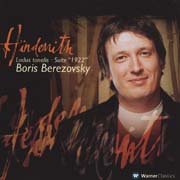

Postludium: Retrograde inversion of the Praeludium.Fuga undecima in B ( canon): Accompanied canon.Fuga nona in B ♭: Subject transformation fugue.Interludium: Romantic miniature ( Brahms style).Interludium: Romantic miniature ( Chopin style).Fuga tertia in F: Mirror fugue, where the second half is an exact retrograde of the first, except with voice paddings at their end exits.

In this system, the major-minor duality is meaningless and the practice of modulation is dropped, although subject modulation occurs in the second fugue, to create growing tension. The affinity of each note with the keynote is directly related to its position on the harmonic scale. Ludus Tonalis can be thought of as the most direct application of Hindemiths theory that the twelve tones of the equally tempered scale all relate to a single. Ludus Tonalis can be thought of as the most direct application of Hindemith's theory that the twelve tones of the equally tempered scale all relate to a single one of them (called a tonic or keynote).

Unlike Bach's work, though, the non-fugal pieces in Ludus Tonalis frequently repeat the work's main theme. Ludus Tonalis was intended to be the twentieth-century equivalent to J.S. The tonalities of the fugues follow the order of his Serie 1 and use the keynote C (see The Craft of Musical Composition). In between, there are twelve three-part fugues separated by eleven interludes, beginning in the tonality of the previous fugue and ending in the tonality of the next fugue (or in a different tonality very close to that). The piece, which comprises all 12 major and/or minor keys, starts with a three-part Praeludium in C resembling Johann Sebastian Bach's toccatas, and ends with a Postludium which is an exact retrograde inversion of the Praeludium. It is in effect, a veritable catalogue of the composer's mature style." The piece explores "matters of technique, theory, inspiration, and communication. It would be interesting to know more about what led to the impetus to respond to Bach, and to demonstrate his own harmonic theory, at this particular moment. It was first performed in 1943 in Chicago by Willard MacGregor. Ludus tonalis was composed in America, in 1942, and it may have been a response partly to Stravinsky, and perhaps also to early works by Babbitt and others. My only half-quibble concerns the pianist’s rather typewriterish flattening out of the Ragtime finale’s syncopations that John McCabe treats more idiomatically. Interludium Kbi LareteiHindemith: Ludus Tonalis 1966 Universal International Mu. The rhythms of 1920s jazz and gray, gnarly Teutonic dissonances collide in the Suite 1922, which Berezovsky’s fingers relish with glee. Ludus Tonalis ("Play of Tones", "Tonal Game", or "Tonal Primary School" after the Latin Ludus Litterarius), subtitled Kontrapunktische, tonale, und Klaviertechnische Übungen ( Counterpoint, tonal and technical studies for the piano), is a piano work by Paul Hindemith that was composed in 1942 during his stay in the United States. Provided to YouTube by Universal Music GroupHindemith: Ludus Tonalis - 5. From the first and final movements, respectively.


 0 kommentar(er)
0 kommentar(er)
